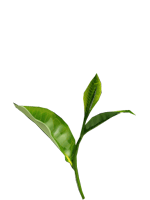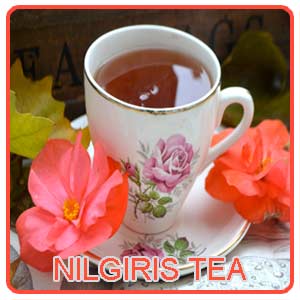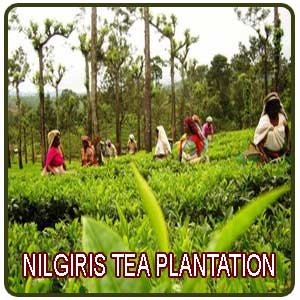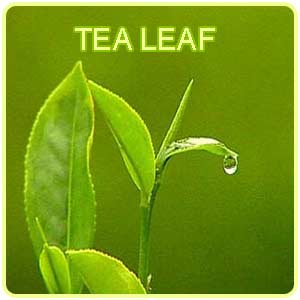 THE NILGIRIS TEA
THE NILGIRIS TEA
-The Nilgiri tea is from the mountains of the Western Ghats in South India in the district of Nilgiris situated in the province of Tamil Nadu. Nilgiris is one of the major tea producing regions in India. The Nilgiri Planters' Association of South India founded in 1981 represents the plantations of this area and accounts for nearly a third of tea production in the district. The two other main tea growers of the country are Assam and Darjeeling which gives a more robust tea when compared to that of the Nilgiris but however it is the Nilgiris that contributes to India's major tea production and the tea produced here retains a range of recognizably "Nilgiri" flavor characteristics. Nearly half of the quantity of tea produced in the Nilgiris is exported and majority of the tea growers in this area do it as small farming which is then sold to separately-owned factories for processing.
 CHRISTIE EXPERIMENTED WITH THE GROWING OF TEA IN NILGIRIS
CHRISTIE EXPERIMENTED WITH THE GROWING OF TEA IN NILGIRIS
-It was in 1832 that Dr. Christie experimented with the growing of tea in Nilgiris and distributed it to different parts of the mountain for trial. Again in 1834 tea plants were grown in Nilgiris from the seeds which were brought in from China. But soon tea from this area went to different other parts of the country especially to the South. In 1875 commercial planting was done in Kerala in Peermade followed by the development of Kanan Devan Hills by James Finlay and Co. in 1878 with tea as an exclusive crop which is a landmark in the history of tea planting in this part of the country. By 1889 Wayanad in the state of Kerala came up with tea growing.
 HYBRID POPULATION- A RESULT OF A NUMBER OF WILD SPECIES OF TEAS
HYBRID POPULATION- A RESULT OF A NUMBER OF WILD SPECIES OF TEAS
--However in Karnataka tea was produced much later when compared to other southern states.Camelliaceae is the family to which tea belongs to and they mostly belong to two distinct species namely Camellia sinensis (L). O. Kuntze, the short leaved 'China' plants and Camellia assamica (Masters) Wight, the broad leaved 'Assam' plants. However now tea is manifested by a number of hybrid populations like 'China', 'Assam' and 'Cambod'. The present day hybrid population is also a result of a number of wild species of teas. The preferable climatic conditions for tea are humid with a well distributed rainfall and bright sunshine days. The pH required for a good successful crop is 6.0 but also a pH of 4.5 to 5.5 is fair enough for a moderately good quality of tea.
 TEA IS NOT A SHRUB BUT WHEN LET IT CAN GROW INTO A TREE
TEA IS NOT A SHRUB BUT WHEN LET IT CAN GROW INTO A TREE-Tea is not a shrub but when let it can grow into a tree which is usually not done but instead pruned into a bush at regular intervals so that it makes plucking easier and for harvesting optimum vegetative growth. One of the main reason for the extensive planting of tea in South India as a whole is the slow fall of the coffee industry where plants were affected by leaf rust. The tea of the Western Ghats is grown at different elevations from 300 to 2,300 m above sea level and the rainfall ranges between 90-750 cm. These plantations, with their adjoining forest ecosystem contribute greatly to the maintenance of terrestrial ecology by providing extensive land cover and minimizing soil erosion.
 SPECIALTY
SPECIALTYPeople have been drinking tea for more than 300 years and especially for a British tea accounts for nearly half the fluid intake. There is sometimes nothing more reviving than a cup of tea, for it is both refreshing and has a lot of medicinal properties. Caffeine which is present in tea is said to increase the heart rate and alertness and also aid in respiration by dilating the airways of the lungs. Nilgiris tea has endured agony to the fact of being placed as a third cousin behind the popularity of Darjeeling's and Assam's. But still Nilgiris tea managed to play a major role in some of the most accomplished gastronome tea ventures in North America. The specialty of Nilgiris tea is that it is featured by the right balance of strength, color and astringency to satisfy the needs of tea drinkers ranging from the layman to the gourmet.
 NILGIRIS TEA - THE GEM OF SOUTH INDIA
NILGIRIS TEA - THE GEM OF SOUTH INDIA-The tea from Nilgiris results in no clouding but instead gives bright and brisk tea liquors. The Nilgiris tea is supposed to be the gem of South India which is yet to be discovered. Tea growing is seasonal in Assam and Darjeeling whereas the tea in Nilgiris is grown throughout the year. Nilgiris tea are more commonly known as the Fragrant one for it is mostly grown in high elevation resulting in superior quality of fragrance and flavor. Tea from Nilgiris has flavors of mint, lemon and eucalyptus because it is usually grown among other trees like eucalyptus, blue gum and cypress. The major auction centre for Nilgiris tea is Coonoor where each week witnesses selling of nearly million pounds and this amount is even doubled during rainy season to about two million pounds. Buyers from International tea market are present at the auction centre to buy the Nilgiris tea.
 TEA FLAVINOIDS SHOW STRONG ANTIOXIDANT ACTIVITY
TEA FLAVINOIDS SHOW STRONG ANTIOXIDANT ACTIVITY -It is proved that a balanced diet with low fat and lot of fiber intake along with drinking of tea forms a key to a healthy lifestyle. There are researches done on the Nilgiris tea which states nearly 20gms of flavinoids antioxidant are present in a cup of black tea. The antioxidant in tea is much more in quantity when compared to that of fruits, vegetables and other beverages. Tea flavinoids show strong antioxidant activity and more powerful than vitamin C and E. Tea is also believed to reduce the risk of heart disease and stroke.
 THE FLAVINOIDS PROTECT LOW DENSITY LIPOPROTIENS FROM OXIDATION
THE FLAVINOIDS PROTECT LOW DENSITY LIPOPROTIENS FROM OXIDATION
The science behind the cardio vascular disease is mainly due to the accumulation of lipid mostly cholesterol, in the inner layers of the arteries or the blood vessels which is a result of high level of low density lipoprotein and LDL, oxidation leading to platelet aggregation and thromboxaine formation.Whereas with the consumption of tea, the flavinoids protect low density lipoproteins from oxidation, inhabit plasma lipid per oxidation and inhabit platelet aggregation and thromboxaine formation. Also the polyphenols present in tea acts as an effective Cancer preventive agent highly rich in biochemical properties. Chronic damage by UV light can lead to skin cancer. Emerging research result shows tea to protect skin from damage and inflammation caused by UV. Effect appears to be the same whether tea is drunk or applied as a topical agent. Most of the beauty products companies have started to use tea as one of the ingredient. There are lot of scientific theories which says that when tea is taken as a beverage it helps in revival of the body by quick physiological stimulation and mind by increased mental alertness improve in mood and reduction in fatigue. Also tea reduces anxiety and makes a person to calm down by increasing the vaso-dilatation of skin blood vessels.
 THE CULTIVATION OF NILGIRIS TEA
THE CULTIVATION OF NILGIRIS TEA
-When it comes to oral health the flaviniods present in tea inhibits the growth of oral bacteria and enzymes responsible for formation of plague. Also tea is a natural source of fluoride and other micro and macro nutrients like potassium, folic-acid, manganese and vitamin K in limited quantity. Tea is absolutely free from fat, sugar, calorie or sodium.
Though the cultivation of Nilgiris Tea is annual and plucking of tea leaves is carried out throughout the year, the main season is between December to March. The tea which is plucked during this season is called as frost tea which is named after the frosty, cooler winter weather, and the real threat of frost that could damage the tea crop. The frost tea never clouds when it is made into an iced tea but instead remains a clear one which is supposed to be one of the unique features of Nilgiris tea.
 THE NILGIRIS TEA IS ALSO CALLED AS CTC
THE NILGIRIS TEA IS ALSO CALLED AS CTC
-The Nilgiris tea is also called as CTC which mainly indicates the production process which it undergoes by namely crush, tear and curl. The CTC machine used in the production is like a big sieve which is fed with fresh leaves and then comes out as a tiny bright green pellets which then passes on a conveyer belt. When it is carried through the conveyer belt hot air is blown from above by powerful blowers, with oxidation taking place in less than an hour. Nearly 95% of the World's tea is CTC tea which is mainly used in tea bags. Though once Nilgiris tea was the pioneer in CTC tea production, now it is facing challenges because of the competition from countries like Argentina and Vietnam, providing a glut of tea and driving down prices for all. Apart from this the global scenario of economy is also changing leading to reduced prices for both export and import market.
 TEA PRODUCED IN NILGIRIS IS MARKETED IN THE AUCTION CENTRE
TEA PRODUCED IN NILGIRIS IS MARKETED IN THE AUCTION CENTRE
-So now the Nilgiris tea growers concentrate more on quality than on quantity and they are switching to organic tea production to stand in the market.The Nilgiris Tea Growers Association has made great progress in changing the way Nilgiris teas are grown and manufactured and the way they are being used in the industry. The tea produced in Nilgiris is mainly marketed in the auction centre at Coonoor from where they are exported to other parts of the country. Nearly 64000 and 120000 tons of tea are produced on an annual basis in Nilgiris and it ranks second in India as the tea producing region next to Assam. Nearly 25% of India's total tea production is from Nilgiris. Nilgiris is benefitted by a good soil and also blessed with nature and even rainfall resulting in a yield of about 3,500 kg/ha and also the tea estates in Nilgiris are very efficiently managed. Tea from Nilgiris is graded into three different qualities based on the elevation they are grown at.
 THE TEAS GROWN AT HIGH ALTITUDE ARE THE MOST FLAVORFUL
THE TEAS GROWN AT HIGH ALTITUDE ARE THE MOST FLAVORFUL
-The teas grown at high altitude are the most flavorful, "mid-grown" teas are of medium quality, and "low grown" teas generally being used as a base for blends. Nilgiri produces some very high quality teas, and also CTC teas, which are used for blending. The tea estates in Nilgiris are mostly managed by small families as business and the area is usually small or medium size with an average extent of about 100 - 200 ha .These business mostly belong to colonial times. There are nearly 30,000 small holders where they own areas of about or even less than 10 hectares. Such small holdings have been increasing rapidly mainly due to the fact that there is a fast increase in tea prices when compared to other crops. These small-holders usually sell their green leaf to the factories which further goes for the processing.
 LARGE PLANTATIONS HAVE MORE THAN 1000 WORKERS EMPLOYED
LARGE PLANTATIONS HAVE MORE THAN 1000 WORKERS EMPLOYED
-Most of the estate workers in Nilgiris are women and they constitute about nearly 60 %. Apart from the small holdings there are also large plantations with an area of 400 hectares or more. Such plantations are often self- reliant where they provide their workers with all facilities like quarters, estate schools, dispensaries and places of worship. Large plantations have more than 1000 workers employed and the ratio is about 2 - 3 workers per hectare. The main auction center for the tea grown in Nilgiris is Coonoor which was established in 1963 and their main aim is to help the small-holder who could not send their teas to the main regional auction center for South India in Cochin and also the center helps in getting a better price for the products. Many of the brokers are Indian-managed companies.
 THE NILGIRIS TEA IS GRADED BASED ON THE SIZE OF THEIR LEAVES
THE NILGIRIS TEA IS GRADED BASED ON THE SIZE OF THEIR LEAVES
-Apart from receiving and auctioning teas the brokers also act as manufacturing advisor and part financier to the plantation owners, especially the small-holders who require advances on their production. Once processing is done the Nilgiris tea is graded based on the size of their leaves like Orange Pekoe, Broken Orange Pekoe, and Flowery Broken Orange Pekoe, etc. After grading they are sent to the warehouses of the brokers in foil- lined plywood chests or lined jute bags to the Cochin port and from there it is then exported across the globe. Some of the popular tea estates in Nilgiri include Tiger Hill, Corsley, Craigmore, Pascoes Woodlands, Colacumby, Nonsuch Dunsandale, Chamraj, Parkside, and Glendale.
 DEALERS OF NILGIRI TEA
DEALERS OF NILGIRI TEA
| 1. The Royal Tea,
(04253) 236248 1/248, Minparai,
Valparai, Attakatti, Valparai,
Coimbatore - 642127
|
| 2. Green Tea Traders, Sanganur Main Road,
Ratnapuri,
Coimbatore - 641027
|
| 3. Skarkar Super market,
No 23 Hotel Charing Cross Complex,
Garden Road, Ooty HO,
Ooty - 643001
|
| 4. Sumangali Tea & Coffee Co,
(0423) 2445042,
18/1186 U M C Market Building, Market,
Ooty - 643001
|
| 5. A B S M Nilgiri Food Products,
(0423) 2446433,
712 C/4 Jumma Masque Building, Lower Bazaar,
, Ooty � 643001
|
 THE NILGIRIS TEA
THE NILGIRIS TEA CHRISTIE EXPERIMENTED WITH THE GROWING OF TEA IN NILGIRIS
CHRISTIE EXPERIMENTED WITH THE GROWING OF TEA IN NILGIRIS HYBRID POPULATION- A RESULT OF A NUMBER OF WILD SPECIES OF TEAS
HYBRID POPULATION- A RESULT OF A NUMBER OF WILD SPECIES OF TEAS TEA IS NOT A SHRUB BUT WHEN LET IT CAN GROW INTO A TREE
TEA IS NOT A SHRUB BUT WHEN LET IT CAN GROW INTO A TREE
 SPECIALTY
SPECIALTY NILGIRIS TEA - THE GEM OF SOUTH INDIA
NILGIRIS TEA - THE GEM OF SOUTH INDIA TEA FLAVINOIDS SHOW STRONG ANTIOXIDANT ACTIVITY
TEA FLAVINOIDS SHOW STRONG ANTIOXIDANT ACTIVITY THE FLAVINOIDS PROTECT LOW DENSITY LIPOPROTIENS FROM OXIDATION
THE FLAVINOIDS PROTECT LOW DENSITY LIPOPROTIENS FROM OXIDATION
 THE CULTIVATION OF NILGIRIS TEA
THE CULTIVATION OF NILGIRIS TEA THE NILGIRIS TEA IS ALSO CALLED AS CTC
THE NILGIRIS TEA IS ALSO CALLED AS CTC  TEA PRODUCED IN NILGIRIS IS MARKETED IN THE AUCTION CENTRE
TEA PRODUCED IN NILGIRIS IS MARKETED IN THE AUCTION CENTRE THE TEAS GROWN AT HIGH ALTITUDE ARE THE MOST FLAVORFUL
THE TEAS GROWN AT HIGH ALTITUDE ARE THE MOST FLAVORFUL
 LARGE PLANTATIONS HAVE MORE THAN 1000 WORKERS EMPLOYED
LARGE PLANTATIONS HAVE MORE THAN 1000 WORKERS EMPLOYED THE NILGIRIS TEA IS GRADED BASED ON THE SIZE OF THEIR LEAVES
THE NILGIRIS TEA IS GRADED BASED ON THE SIZE OF THEIR LEAVES DEALERS OF NILGIRI TEA
DEALERS OF NILGIRI TEA


